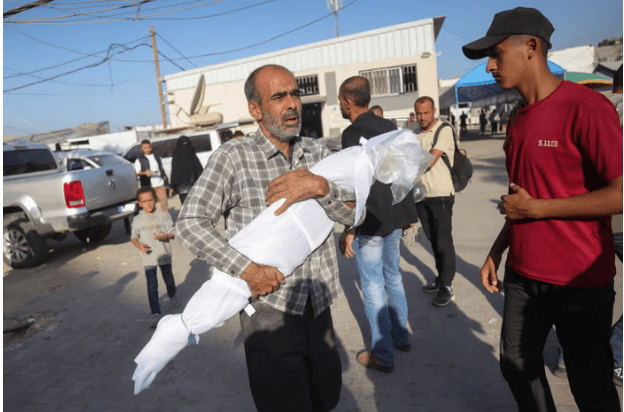The Trump-Netanyahu Gaza ceasefire faces collapse. Get the latest on the US-brokered agreement, violation claims, and the urgent humanitarian situation in Gaza.

Trump, Netanyahu, and Gaza Ceasefire Faces Collapse Amid Renewed Hostilities
The Trump-Netanyahu Gaza ceasefire is on the brink of total collapse. A new wave of violence now threatens this US-brokered agreement. Both sides are trading accusations of violations. The situation on the ground is deteriorating rapidly. This report covers the latest developments in this critical Middle East crisis.
US-Brokered Truce Tested by Sudden Escalation
The fragile Trump-Netanyahu-Gaza ceasefire faced its most severe test this weekend. Israeli forces reported attacks from Hamas militants in southern Gaza. The Israel Defense Forces (IDF) confirmed two soldier fatalities. These were the first Israeli military deaths since the truce began.
In response, the IDF launched “extensive strikes” on Hamas targets. Prime Minister Benjamin Netanyahu authorized the military operation. He called the Hamas attack a “blatant violation” of the agreement. The Israeli cabinet convened for an emergency session.
Hamas’s military wing, the Al-Qassam Brigades, issued a denial. They claimed no knowledge of clashes in the Rafah area. The group accused Israel of creating a false pretext for renewed attacks.
Civilian Toll Rises in Gaza Amidst Renewed Conflict
The human cost of this escalation is severe. Palestinian sources report significant casualties from Israeli airstrikes. Gaza’s civil defense agency updated the death toll to at least 45 people.
Strikes hit multiple locations across Gaza:
- Central Gaza’s Zuwaida town
- The Nuseirat refugee camp
- Khan Younis, where a drone hit a displaced person’s tent
- A residential building in Gaza City
The Palestinian Ministry of Health reported overwhelmed hospitals. Medical facilities were already operating at limited capacity. The renewed violence threatens to create a new wave of humanitarian suffering.

Key Provisions of the Trump Netanyahu Agreement
The Trump-Netanyahu Gaza ceasefire represented a comprehensive peace plan. The 20-point agreement included several crucial elements. Understanding these terms helps explain the current crisis.
The agreement mandated:
- Immediate cessation of all hostilities
- Partial Israeli troop withdrawal to designated lines
- Release of all living hostages held by Hamas
- Return of the deceased hostages’ remains
- Significant increase in humanitarian aid to Gaza
Before the recent violence, the agreement showed promising results. Hamas had released all 20 remaining living Israeli hostages. Israel had freed hundreds of Palestinian prisoners. The aid flow into Gaza had improved substantially.
Humanitarian Consequences of Ceasefire Breakdown
The disruption of the Trump-Netanyahu Gaza ceasefire has immediate humanitarian impacts. Approximately 2.1 million people in Gaza depend on aid for survival. The recent violence has jeopardized this lifeline.
Israeli authorities initially closed crossing points for aid convoys. This threatened to worsen the already dire situation. A UN-declared famine in the Gaza City areas made the aid suspension particularly dangerous.
Later developments brought some relief. A senior Israeli official confirmed aid deliveries would continue. However, the key Rafah border crossing with Egypt remained closed. This creates uncertainty about future aid flows.
Humanitarian Impact Assessment
| Aspect | Pre-Escalation Status | Current Status |
|---|---|---|
| Aid Delivery | 190,000 tonnes approved | Partially restored |
| Border Access | Rafah crossing operational | Closed until further notice |
| Civilian Safety | Nine days of relative calm | Dozens killed in new strikes |
| Medical Capacity | Limited but stable | Overwhelmed with new casualties |
Diplomatic Efforts to Salvage the Ceasefire
Intense diplomatic efforts are underway to preserve the Trump-Netanyahu Gaza ceasefire. A senior Egyptian official reported “round-the-clock” contacts. The goal is to prevent the complete collapse of the agreement.
The United States remains actively engaged. Vice President JD Vance is expected to lead a US delegation to Israel. Original ceasefire architects Steve Witkoff and Jared Kushner are returning to the region. Their mission is to reinforce implementation efforts.
By Sunday evening, the Israeli military announced renewed enforcement of the ceasefire. The statement followed what Israel called “significant strikes in response to Hamas’ violations.” The IDF pledged to continue upholding the agreement while responding firmly to any violations.
Regional Reactions and Political Implications
The crisis has drawn strong reactions from regional stakeholders. The Council on American-Islamic Relations (CAIR) denounced Israel’s airstrikes. The group described the bombings as a “resumption of the genocide.” They called on President Trump to restrain Israeli forces.
Hamas dismissed US State Department allegations about planned attacks. The group called the accusations “false” and aligned with “Israeli propaganda.” Meanwhile, Hamas continues to leverage control over hostage remains.
The group announced the location of another Israeli hostage’s body. They stated willingness to hand it over if “field conditions allow.” However, they warned that continued airstrikes would make such transfers impossible.
Hamas’s Political Maneuvering Amidst Crisis
Beyond the immediate violence, political dynamics are evolving. Hamas is attempting to reassert authority in Gaza. Regional analyses indicate the group has moved quickly to regain control.
Hamas has rebranded its fighters as “Gaza Security Forces.” They’ve deployed them in civilian clothing across urban areas. This contradicts the Trump administration’s peace plan. The agreement explicitly calls for disarming Hamas and removing it from administrative structures.
Doha-based Hamas leader Mohammed Nazzal defended the group’s actions. He described refusal to disarm and public executions as necessary wartime measures. These developments highlight implementation challenges for the US and regional partners.
The Path Forward for US-Mediated Peace
The Trump-Netanyahu Gaza ceasefire now faces its ultimate test. The agreement’s architecture remains theoretically intact. However, trust between the parties has been severely damaged.
Several factors will determine the ceasefire’s survival:
- Both sides’ willingness to return to compliance
- Effectiveness of US and Egyptian mediation
- Ability to maintain humanitarian aid flows
- Containment of incidents by smaller militant groups
The United States faces particular challenges. The administration must balance support for Israel with preserving its mediation role. It must also address Hamas’s political positioning while maintaining humanitarian principles.
Conclusion: Uncertain Future for Middle East Peace
The Trump-Netanyahu Gaza ceasefire hangs in the balance. Sunday’s violence demonstrated the agreement’s fragility. While both sides have reaffirmed their commitment, the situation remains volatile.
The coming days will be crucial. Either the parties will step back from escalation, or the region could see full-scale conflict resume. The humanitarian consequences of renewed war would be catastrophic.
International attention remains focused on the region. The world watches whether diplomacy can prevail over violence. The fate of millions depends on the outcome.

